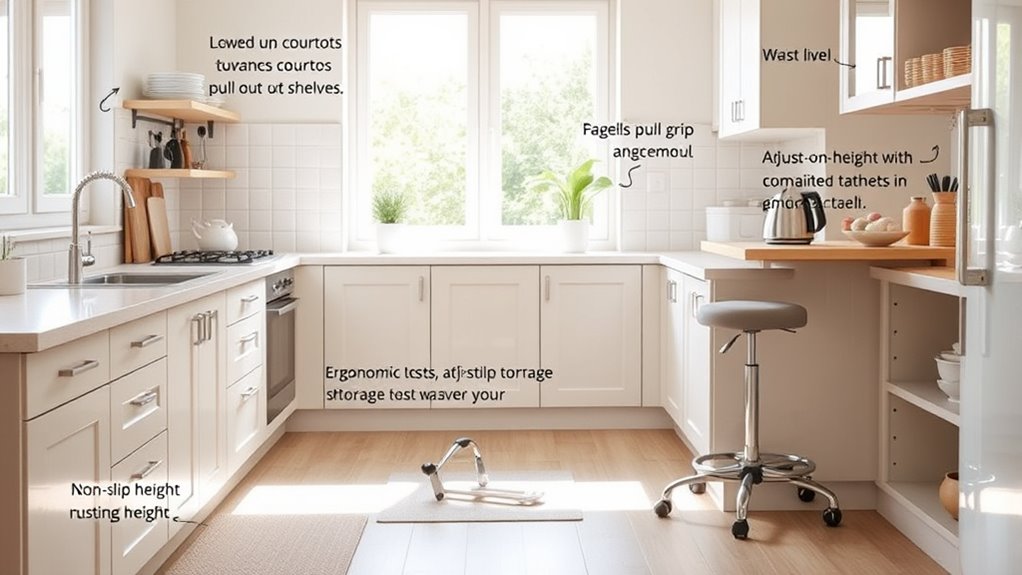To set up an ergonomic kitchen for arthritic cooks, start by arranging frequently used items within easy reach and keeping your workspace clutter-free. Choose tools with ergonomic grips and lightweight materials, and consider adjustable countertops or workstations to prevent strain. Incorporate assistive devices like jar openers and non-slip mats for safety and comfort. Organizing your space effectively minimizes bending and reaching, making cooking easier—and exploring further can help you create a truly accessible kitchen.
Key Takeaways
- Arrange frequently used items at waist or countertop height to minimize bending and reaching.
- Use ergonomic tools with non-slip handles and lightweight materials to reduce joint strain.
- Install adjustable-height countertops and work surfaces for personalized comfort and flexibility.
- Incorporate cushioned mats and anti-fatigue solutions to support standing and reduce fatigue.
- Keep the workspace well-lit, organized, and clutter-free to enhance safety and ease of access.
Optimizing Your Kitchen Layout for Ease of Use
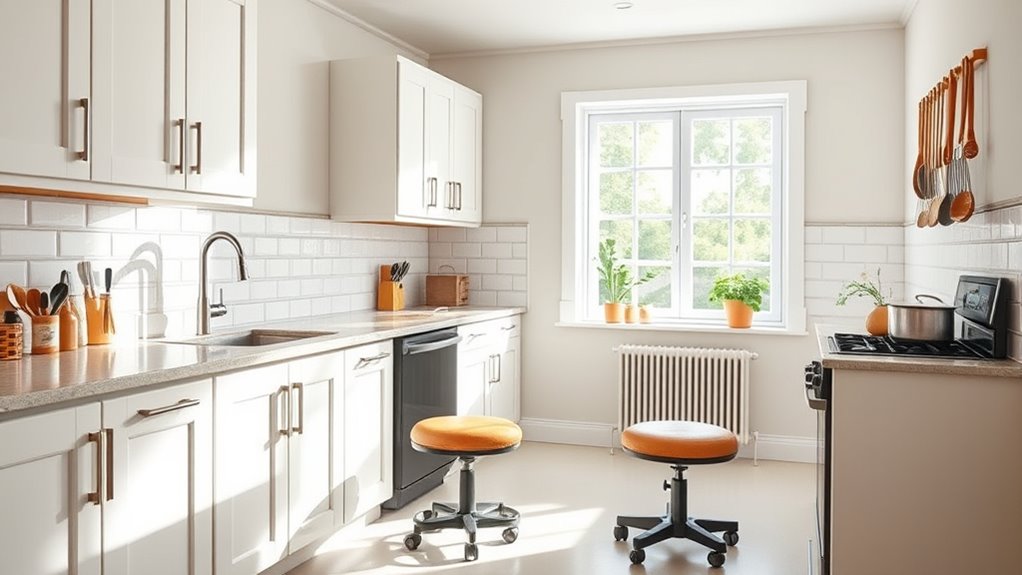
Have you ever considered how your kitchen layout affects your comfort and safety while cooking? An efficient layout minimizes unnecessary movement and reduces strain on your joints. Start by arranging frequently used items within easy reach—place utensils, spices, and cookware close to your prep and cooking areas. Keep your workspace clear of clutter to prevent accidents and make movement smoother. Consider installing lower countertops if standing for long periods causes discomfort, and ensure there’s enough space to move freely. Keep heavy pots and pans stored at waist level to avoid lifting injuries. Good lighting is essential to prevent eye strain, especially when handling sharp tools. Additionally, understanding ergonomic principles can help you design a kitchen that minimizes fatigue and maximizes comfort. Incorporating natural materials like wood and stone can also enhance comfort and aesthetics in your kitchen. Utilizing ergonomically designed tools and accessories can further reduce joint strain and improve your cooking experience. By thoughtfully organizing your kitchen, you create a safer, more comfortable environment tailored to your needs.
Choosing Ergonomic Tools and Equipment

When selecting tools, look for ergonomic grip handles that reduce strain and improve control. Lightweight kitchen gadgets can make cooking easier and less tiring for your hands. Choosing these features can considerably enhance your comfort and efficiency in the kitchen. Incorporating sound vibrations into your selection process can also promote relaxation and reduce stress during meal preparation.
Ergonomic Grip Handles
Choosing ergonomic grip handles is essential for reducing strain on arthritic hands and making kitchen tasks more manageable. These handles provide a comfortable, secure grip, lowering the effort needed to hold utensils and tools. When selecting tools, look for handles designed with soft, non-slip materials that conform to your hand’s shape. Consider the size and contour—larger, rounded handles often require less grip strength. To help you compare options, here’s a quick guide:
| Handle Type | Benefits |
|---|---|
| Soft Rubber | Cushions grip, reduces pressure |
| Wide, Rounded | Easier to hold, minimizes hand fatigue |
| Textured Surface | Prevents slipping, increases control |
Choosing the right ergonomic grip handles can make cooking safer and more comfortable.
Lightweight Kitchen Gadgets
Opting for lightweight kitchen gadgets can considerably ease the physical effort required for cooking, especially for those with arthritis. These tools reduce strain on your joints, making prep work more manageable. Look for utensils made from lightweight materials like plastic or aluminum, which are easier to handle without sacrificing durability. Items such as lightweight pots, pans, and mixing bowls help prevent fatigue and discomfort. Ergonomic handles combined with lighter weight make it easier to grip, lift, and maneuver. Avoid heavy, bulky gadgets that require excessive force. Instead, choose tools designed with your comfort in mind. This approach not only minimizes joint pain but also helps you cook more independently and safely, transforming your kitchen into a more accessible space.
Adjusting Counter Heights and Work Surfaces
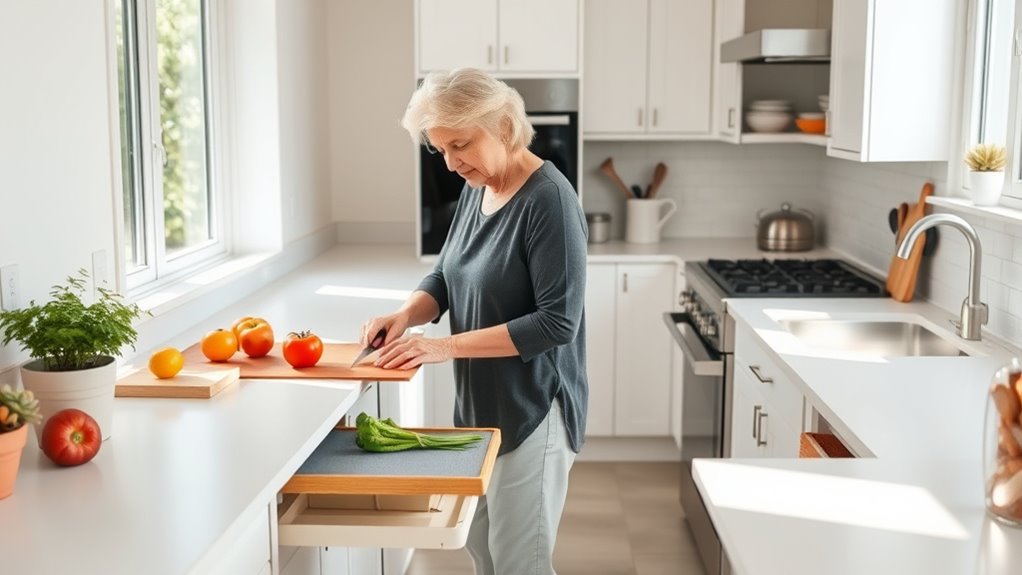
Adjusting your counter heights and work surfaces can make cooking much easier on your joints. You should consider ideal counter height choices and explore adjustable options to find what feels best for you. Ergonomic tools and accessories can further enhance comfort and reduce strain during meal prep. Incorporating beneficial ingredients like collagen or hyaluronic acid into your routine, such as through specialized eye patches, can support skin health and reduce signs of aging around the eyes, further contributing to overall comfort. Additionally, embracing creative practice by experimenting with new kitchen layouts or tools can help you discover innovative solutions that improve your cooking experience and minimize joint stress. Exploring remote hackathons can inspire innovative ways to adapt your kitchen setup through collaborative ideas and virtual inspiration. Understanding Gold IRA rollovers can also provide valuable insight into diversified investment strategies that secure your financial future, paralleling the importance of ergonomic planning in your kitchen. Incorporating ergonomic principles, such as proper posture and tool placement, can further optimize your kitchen environment for arthritis-friendly cooking.
Optimal Counter Height Choices
To create a comfortable and safe workspace for arthritic cooks, selecting the right counter height is essential. The ideal height depends on your height and task needs. Generally, counters should be around waist to elbow level for ease of use. If you find yourself bending or reaching, consider lowering or raising your countertops. Use the table below to determine your best height:
| User Height | Recommended Counter Height |
|---|---|
| Under 5’4″ | 34-36 inches |
| 5’4″ – 5’8″ | 36-38 inches |
| 5’8″ – 6’0″ | 38-40 inches |
| 6’0″ and above | 40-42 inches |
| Multi-purpose | Adjustable or varied heights |
Choosing the right height reduces strain, easing arthritis symptoms and making cooking safer.
Adjustable Work Surface Options
Choosing the right work surface height can substantially reduce strain on arthritic joints during cooking. Adjustable work surfaces let you customize your countertop height to fit your needs, making meal prep more comfortable. You can opt for a sit-stand workstation or install adjustable-height tables, which allow you to switch between sitting and standing positions easily. This flexibility helps minimize repetitive strain and joint pain. When selecting adjustable options, consider easy-to-use mechanisms, such as pneumatic or electric lifts, so you can modify the height without hassle. Ensuring your work surface can be raised or lowered as needed makes your kitchen more ergonomic, helps preserve joint health, and makes cooking less tiring. Properly adjusted work surfaces are a simple yet effective way to improve your kitchen experience.
Ergonomic Tools and Accessories
Ergonomic tools and accessories play a essential role in making your kitchen more comfortable for arthritic cooks by allowing you to modify work surfaces easily. Adjustable height countertops, anti-fatigue mats, and lightweight utensils help reduce strain and improve stability. These tools enable you to customize your workspace to fit your needs, minimizing awkward postures and repetitive movements. For example, a height-adjustable work surface can be set to your ideal level, easing back and shoulder stress. Below is a table of useful tools:
| Tool/Accessory | Benefit |
|---|---|
| Adjustable Counter Heights | Customizes work surface to your ideal height |
| Anti-Fatigue Mats | Cushions feet and reduces leg fatigue |
| Lightweight Utensils | Easier to grip and maneuver |
| Non-slip Mats | Prevents slipping and enhances safety |
| Drawer Pulls and Handles | Easier to open with limited grip strength |
Incorporating Assistive Devices and Accessories
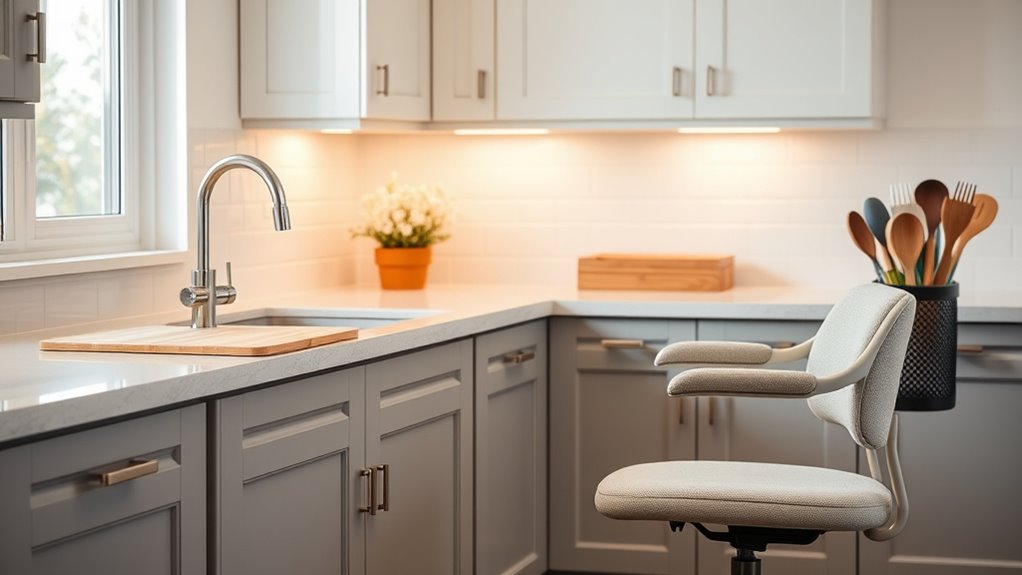
Incorporating assistive devices and accessories into your kitchen can substantially ease the challenges of cooking with arthritis. These tools are designed to reduce strain and make tasks more manageable. For example, jar openers help you easily access stubborn lids, while ergonomic handles on utensils provide a comfortable grip. Lever-style faucets require less force to operate, minimizing hand fatigue. Non-slip mats and grips on cutting boards or bowls prevent slips, increasing safety. Electric can openers and food choppers can save your joints from repetitive effort. By choosing these accessories, you reduce discomfort and conserve energy during meal prep. Incorporating kitchen textiles and accessories such as cushioned mats and easy-to-hold utensils can further enhance comfort. Additionally, incorporating sound design principles such as clarity and simplicity into your kitchen setup can also improve usability for arthritic cooks. Introducing specialized dog training guides can also offer helpful techniques for managing day-to-day routines. Additionally, selecting ergonomic kitchen tools designed specifically for arthritis can further enhance comfort and efficiency. Using assistive technology in the kitchen can help streamline tasks and reduce physical strain, making cooking more accessible. Integrating assistive devices tailored to your needs transforms your kitchen into a more accessible and comfortable space, empowering you to cook with greater independence.
Organizing Your Kitchen for Accessibility and Efficiency
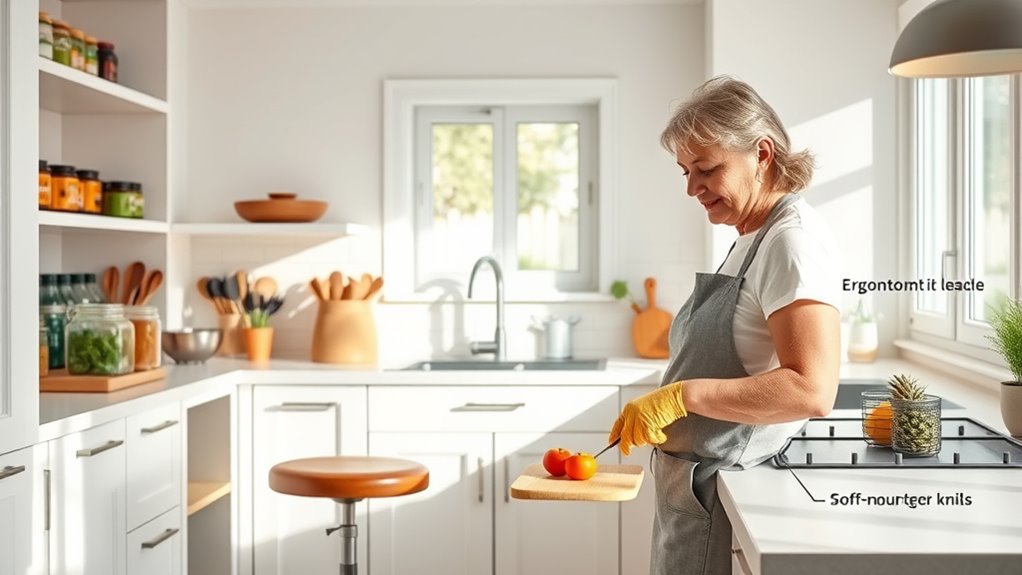
To make your kitchen more accessible and efficient, start by thoughtfully arranging your tools and appliances so everything you need is within easy reach. Keep frequently used items at waist level or in open cabinets to minimize bending and stretching. Use clear storage bins and labels to quickly identify contents. Organize your workspace so that prep areas, cooking zones, and cleanup stations flow seamlessly. Implementing vertical storage solutions can further optimize space and improve accessibility. Additionally, selecting appliances with ergonomic features can reduce strain during use and enhance overall comfort.
Tips for Safe and Comfortable Food Preparation

Creating a safe and comfortable food preparation area is essential, especially if you have arthritis. To reduce strain and prevent injury, focus on minimizing awkward movements and supporting your joints. Use tools like ergonomic knives with non-slip handles, cushioned mats to stand on, and adjustable-height countertops for better posture. Keep frequently used items within easy reach to avoid unnecessary stretching. Make certain your workspace is well-lit to prevent accidents and allow clear visibility. And don’t forget to take regular breaks to stretch your hands and arms. Using mailing list segmentation can also help you tailor your shopping list and meal prep routines to your specific needs. Incorporating ergonomic principles into your kitchen setup can further enhance comfort and safety. Here are some tips to keep your food prep safe and comfortable:
- Use lightweight, easy-to-handle utensils and cutting tools
- Organize your workspace to minimize reaching and bending
- Incorporate assistive devices like jar openers or grip aids
Frequently Asked Questions
What Are the Best Materials for Ergonomic Kitchen Countertops?
When choosing materials for ergonomic kitchen countertops, you want options that are durable, smooth, and easy to clean. Materials like quartz, solid surface, and laminate are excellent because they resist scratches and stains, reducing effort and strain. These surfaces also provide a gentle, consistent height, making cooking more comfortable, especially if you have arthritis. Prioritize lightweight, non-porous materials to ease maintenance and minimize joint stress during use.
How Can I Reduce Fatigue During Prolonged Cooking Sessions?
In an era where even a quill can feel heavy, you can reduce fatigue during long cooking sessions by taking regular breaks and stretching often. Use ergonomic tools to minimize strain, keep everything within easy reach, and maintain good posture. Stay hydrated and switch tasks to prevent overuse of specific muscles. These simple steps help you stay comfortable and energized, turning a tiring marathon into a manageable culinary adventure.
Are There Specific Brands Known for Ergonomic Kitchen Products?
When choosing ergonomic kitchen products, you might wonder which brands stand out. Brands like OXO, KitchenAid, and Joseph Joseph are known for their user-friendly designs that reduce strain. OXO’s Good Grips line, in particular, offers tools with soft, non-slip handles perfect for arthritic hands. Look for products labeled as ergonomic or designed for ease of use, and you’ll find options that make cooking more comfortable and less tiring.
How Often Should Ergonomic Kitchen Equipment Be Replaced or Maintained?
You ask how often ergonomic kitchen equipment needs replacing or maintenance. Think of it like a superhero sidekick—if you ignore it, it’ll stop saving the day! Regularly check for wear and tear every few months, and clean or tighten parts as needed. Replace anything that’s damaged or no longer functions smoothly. By staying vigilant, you’ll keep your kitchen safe, comfortable, and ready to tackle any culinary challenge!
Can Ergonomic Modifications Be Customized for Different Types of Arthritis?
Yes, ergonomic modifications can be customized for different types of arthritis. You can choose tools with softer grips if you have rheumatoid arthritis or lightweight utensils if you struggle with osteoarthritis. Adjusting handle sizes, adding cushioned grips, or using electric appliances can help reduce strain. By tailoring your kitchen setup to your specific condition, you make cooking easier, safer, and more comfortable, allowing you to maintain independence and enjoy your time in the kitchen.
Conclusion
Creating an ergonomic kitchen makes cooking easier and safer for you. Did you know that nearly 23% of people over 65 live with arthritis, making accessible design essential? By optimizing your layout, choosing the right tools, and incorporating assistive devices, you can reduce strain and enjoy cooking again. Small adjustments can make a big difference in your comfort and independence. Take these steps to transform your kitchen into a space that works for you, every day.
